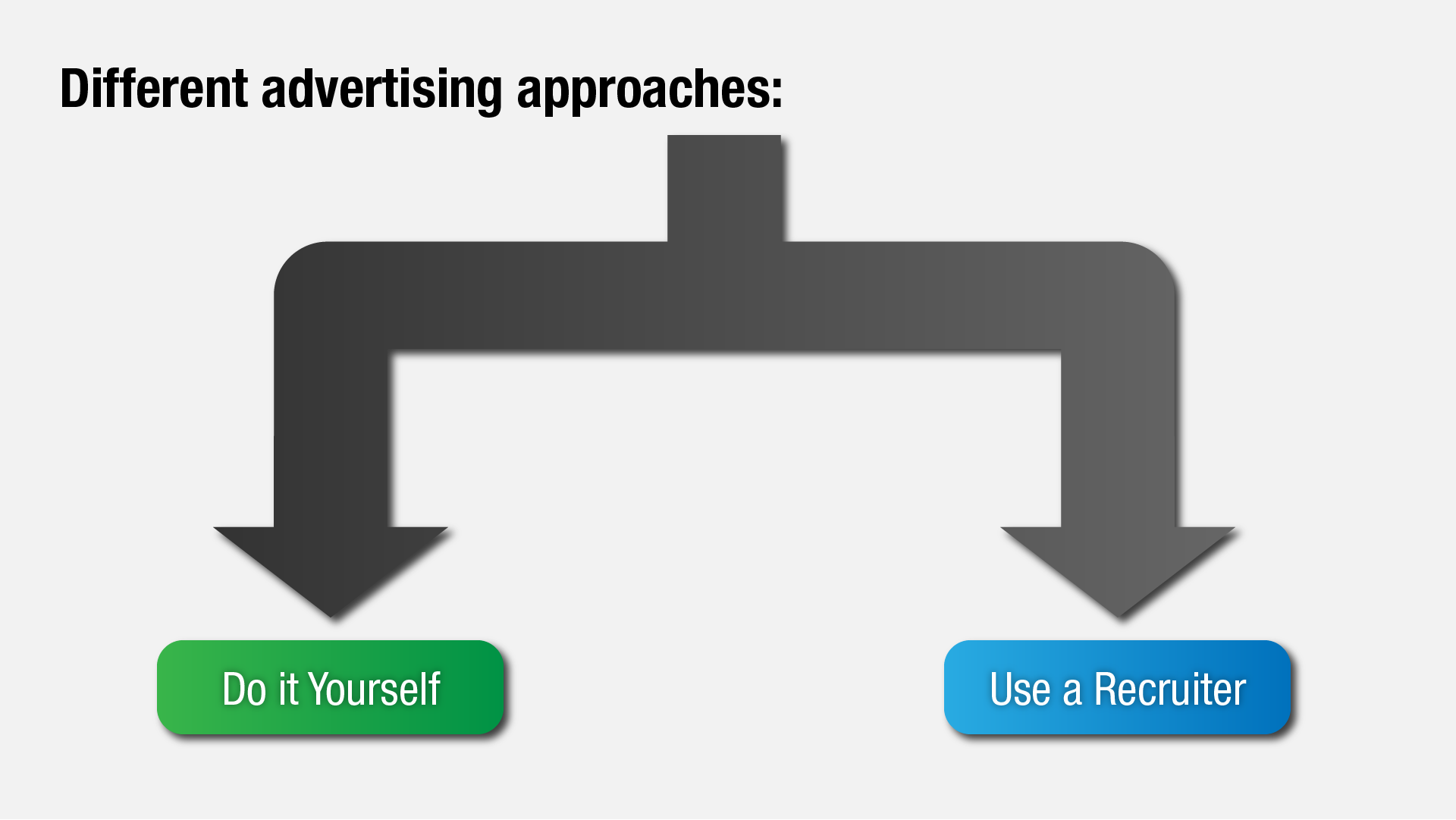Now that you’re prepared and have everything in place, you can start advertising your job opening. there are two common routes when advertising and hiring.

Using a Recruiter
Using a recruiter replaces the need for you to conduct advertising, shortlisting and part of the selection process. They specialise in reaching out to the labour market and finding the right candidate for your role and business.
Every recruiter has their own process they will follow, typically involving a brief with you. From the brief, they will get a better understanding of the role and company and what sort of skills you want the candidate to have. From there the recruiter will advertise then screen the applicants to pass on to you to interview as the most likely candidates.
The cost of a recruiter is based off the wage/salary range of the role that you are hiring for; this can be in the field of 10-30% of the annual salary of the position you are hiring.
Choosing the right recruiter can also help you find the best candidates for the role, especially if you are looking to fill highly skilled or qualified positions. In sector recruiters who specialise in your industry can bring you the right candidates for the role.
See the top 5 Trends in Recruiting for 2019 by Stellar.
Doing it Yourself
You might be accustomed to the ‘old fashioned’ way of advertising positions using word of mouth, and the old ways were popular for a reason, people you know , or know of refer candidates to you and provide a measure of assurance knowing that if people you know recommend them, then there must be some merit in their abilities.
In cases where you are after a more skilled role or have found it hard to either find staff or good ones, then you could consider advertising your role to further your reach.
Online job boards like Seek, TradeMe and LinkedIn comprise the most popular places potential employees browse for new jobs. Each has they’re own slightly different audience which may determine where you spend more on a prominent ad. E.G. LinkedIn usually has a professional audience and more likely to be browsed by highly skilled or qualified professionals.
There are also more specialised online places to list your openings too, like the Connexis run Workforce site.

Make a great ad! To get the right sort of interest you want to have a compelling job ad, more so when you’ve got competition.
What you want to include:
- What the Role is about
Briefly describe what the role is, and maybe a day to day run over what you could be doing. - Your must haves and good to haves
It can be helpful to make these known in the ad; that way, when applying candidates can see what you want and tell you what they can bring to the business. You could also ask candidates to explain how they meet your requirements and provide a cover letter informing you about themselves and why they’d be your ideal candidate. - Your company culture and goals
Tell people a bit about your culture, maybe what the right candidate will have and your goals as a business, if you’re hiring a junior role, this could tell them there is a growth opportunity and if it’s a senior role they can see you mean business and provide a great place to work. - What they’ll get
Talking about money upfront has its pros and cons; ultimately, it’s up to you on whether you disclose your salary expectations or leave that to the interview. You definitely should still talk about what someone can expect as remuneration and benefits. If you’re offering some great benefits, why not list them in the ad? This can help further differentiate your company as the place to work. - Sell It!
Your job listing shouldn’t list everything thing an employee needs to do, nor should it be overly vague and short. Hitting that sweet spot is easier said than done, but once you’ve written out your ad read it back as if you were your ideal candidate, does your ad scream, yell or whisper work for me? Or does it tell you something else?
Head Hunting
Head Hunting is approaching a specific person you may have had in mind or know has the skills and fit you are looking for in your role. Typically head hunting is more costly in the long run than other methods of recruitment, as you are trying to persuade someone to leave their current job and work for you even though they may not have considered leaving. You may likely need to offer more remuneration and benefits to entice them to leave and work for you. Additionally, your company culture plays an essential role in attracting staff, as a great workplace can also work to bring people over.
Also, consider what their current employment contract may stipulate, such as restraint of trade in their current industry for a certain amount of time after leaving.
This article is part of a series on Deciding to Hire.
Next up: The Selection and Hiring Process ►
1. Deciding to Hire
2. Planning the Role
3. Advertising the Role
4. The Selection and Hiring Process
5. Choosing a Candidate to Hire
*Please note this was written as a guide only and is not advice or a replacement for qualified advice/expertise in hiring and it's legal requirements.





